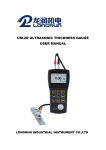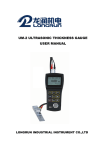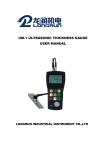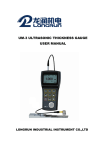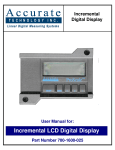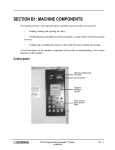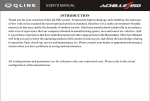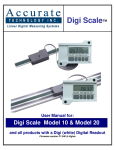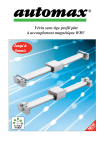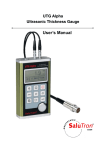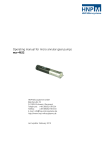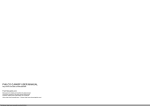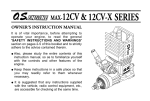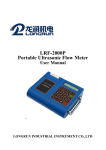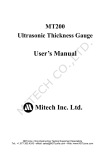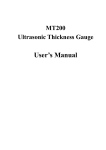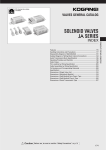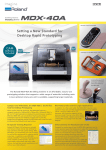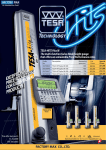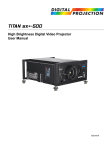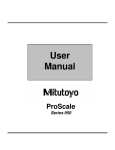Download UM-1D ULTRASONIC THICKNESS GAUGE USER MANUAL
Transcript
UM-1D ULTRASONIC THICKNESS GAUGE USER MANUAL LONGRUN INDUSTRIAL INSTRUMENT CO.,LTD Content 1. General information of the gauge………………………………..…1 1.1 Measuring mode change…...…………………………………….…1 1.2 Basic configuration and names of various parts………….…1 1.2.1 Name of various parts……………………………………………1 1.2.2 Standard configuration…………………………………………..2 1.2.3 Optional configuration……………………………………………2 2. Specifications………………………………………………………………..2 3. Main functions……………………………………………………………….4 4. Measuring steps…………………………………………………………….4 4.1 Gauge preparation……………………………………………………4 4.2 The setting of velocity………………………………………….……5 4.3 Velocity measurement………………………………………………5 4.4 Gauge calibration……………………………………………….……6 4.4.1 Fast calibration……………………………………………………6 4.4.2 2-point calibration……………………………………………..…6 4.4.3 Difference between fast calibration and 2-point calibration.…6 4.5 Thickness measurement……………………………………………6 5. Thickness value storing and checking………………………….…7 5.1 Thickness storing……………………………………………………..7 5.2 Thickness checking……………………………………………..……8 6. Erasing the storing thickness values……………………….………8 6.1 Erasing an individual thickness value……………………...……8 6.2 Erasing the present file…………………………………………..…9 6.3 Erasing all data………………………………………………………10 i 6.4 Erasing CAL data……………………………………………………10 7. System setup and function setup……………………………….…10 7.1 System setup…………………………………………………………10 7.2 Function setup…………………………………………………..……11 7.3 Setting the measuring unit, probe and resolution…….……11 7.4 Min capture……………………………………………………………12 7.5 2-point calibration……………………………………………..……13 7.6 Brightness setting…………………………………………...……...14 7.7 Limits setting…………………………………………………………15 7.8 The backlight function………………………………………..……15 7.9 The low voltage warning function……………………….………16 7.10 Ways of turning off……………………………………………..…16 8. Measurement applied skills…………………………………….……16 8.1 The condition requirements on the surface of the work-piece……………………………………………………………16 8.1.1 Clean surface……………………………………………………16 8.1.2 Enhancing the roughness requirement…………………..……16 8.1.3 Surface of the rough machine processing………….…………17 8.2 Measuring methods………………………………………...……..17 8.2.1 Single-point measurement………………………………..……17 8.2.2 Double-point measurement……………………………….……17 8.2.3 Multiple-point measurement……………………………..……18 8.2.4 Continuous measurement………………………………...……18 8.3 Methods for measuring pipe walls……………………..………18 8.4 Cast Measurement………………………………………….………19 9. Maintenances and cautions…………………………….……………19 ii 9.1 Power source inspection…………………………………….……20 9.2 Cautions………………………………………………………….……20 9.2.1 General cautions…………………………………………..……20 9.2.2 Measuring cautions………………………………………..……20 9.2.3 Changing the probe………………………………………..……20 9.3 Maintenances……………………………………………..…………21 10. After-sale services………………………………………………………21 Appendix A: Sound Velocities of some Common Materials..22 Appendix B: Probe and Measuring Range…………………………23 Appendix C: Various Types of UM series and part of the specifications…………………………………………….…24 Appendix D: The difference among the five types of UM series ultrasonic thickness gauge……………25 iii 1. General information of the gauge There are two operating modes of UM-1D ultrasonic thickness gauge: standard mode and coating mode. The operating principle of coating mode is E-E (echo-echo). When there is coating or oil paint on the surface of the object, the net thickness of the material can be directly measured neither having to remove the coating nor calibration. While the defect of this mode is that the measuring range is relatively narrow: 0.118in-0.709in (with standard probe). The operating principle of standard mode is P-E. With the covered coating, the measurement will not be very accurate, so the coating should be removed before measuring in standard mode. The advantage of this mode is that the measuring range is relatively wide: 0.031in-19.685in (with standard probe). 1.1 Measuring mode change Press MENU key to make “Std/Coat” into highlighted, and then press ENTER to alter between the two modes. 1.2 Basic configuration and names of various parts 1.2.1 Name of various parts -1- LCD Screen Display: m/s——unit of material velocity BATT——Sign of low voltage mm or inch——units of thickness 凸——Sign of good-coupling Keyboard Function Illustration: ON——Open MENU——Menu CAL——Calibration VEL——Velocity MEM——Memory ——Backlight ——Enter △▽——Turn 1.2.2 Standard configuration UM series thickness gauge Standard probe Carrying case Two 1.5V AA alkaline batteries Couplant Operating manual Certification of quality Packaging list Insurance card 1.2.3 Optional configuration Attachable rubber case Numerous special probes on request (High-temperature probe, cast iron probe, small probe, mini probe) Probe cables Couplants and high-temperature couplant 4-step/6-step block for calibration Data transmission cable Application software 2. Specifications Operating principle: Standard mode: P-E (pulse-echo) method with dual-element probes Coating mode: E-E (echo-echo) method with dual-element probes Probe zero adjustment: Selectable: 1-point calibration: normal measurement 2-point calibration: curve surface measurement or other special application with a high precision V-path correction: Automatic Measuring range: 0.8mm to 300mm; 0.031in to 11.81in in standard mode 3.0mm to 18.0mm; 0.118in to 0.709in in through coating mode -2- Depending on probe, material and surface condition Measuring limits of tube: Φ20mm×3.0mm(PT-08 probe),Φ15mm×2.0mm(PT-06 probe) The measuring error is up to ±0.1mm Digital resolution: 0.001in or 0.1mm Units: Selectable: inch or mm Display: 128×64 dot-matrix LCD screen (1.65in×2.24in; 42mm×57mm) EL backlight and switchable contract ratio Digit height: 0.54in or 13.75mm Measurement update rate: 4 Hz in standard measurement mode 25 Hz in MIN capture mode Material velocity range: 1000 to 9999 m/s; 0.039 to 0.394 inch/µs Power: Two 1.5V AA alkaline batteries Warning with low battery voltage Operating time: Up to 200 hours (without backlight) with alkaline batteries, depending on operating mode Auto shut-off: After 5 minutes of non-use Operating temperature: -10℃ to +50℃; +14℉ to +122℉ Specification to -20℃/-4℉ on request Size: 5.86in×2.87in×1.25in; 149mm×73mm×32mm (H×W×D) Weight: 200g; 7oz (including batteries) Data logger capacity: Up to 500 readings can be divided into 5 files (user-selectable) Operating language: English and Chinese Measuring error: Up to 1in: ±0.002in or ±0.1mm Above 1in: ± 1%H H is the height of the testing object Repeatability: ±0.001in or±0.1mm Application software: UMVIEW -3- Interfaces: Serial RS 232C port in combination with a communicative cable; Data transfer parameters: 8 bits, 1 stop bit, 9600 baud, no parity. 3. Main functions ☆ Two operating modes available: standard mode and coating mode. ☆ Data logger: Up to 500 readings can be divided into 5 different material files for easy store and management. The data cannot get lost after power off. ☆ Thickness restriction alarm: set the thickness limits and the value out of the limits will cause the alarm ringing. ☆ Minimum value scanning (MIN Capture mode): catch the minimum value during the measurement. ☆ 2-point calibration: Curve surface measurement or other special application with a high precision. ☆ Supporting thickness units of mm and inch. ☆ The calibration value can be stored automatically without loss after turning off the gauge. ☆ Low voltage warning function. ☆ Backlight: Bring convenience to night working. ☆ Delete: The skeptical data in the file or the whole file can be deleted, so that new data can be stored. ☆ Automatic shut off: No operation in 5 minutes. ☆ Language: English and Chinese. ☆ Coupling status awareness: The stability of coupling can be aware by the coupling sign. 4. Measuring steps 4.1 Gauge preparation After plugging-in the probe connector to the gauge and pressing ON, there will be two beep and the screen lights up. The velocity displayed is that of last time. The screen display is as follows: Save1 Menu Std 5900 ▲ -4- OFF m/s 4.2 The setting of velocity With the known velocity of the material, the build-in velocity can be set manually according to the Velocity List in the appendix. Totally, there are 5 velocities can be stored in the gauge. The steps are as follow: If the present display is not the velocity, press VEL to enter the velocity status. The velocity in the present velocity storing file will display and every time you press VEL, the 5 velocities will change in turn. See the following figures: Save1 Menu Std 5900 ▲ OFF Save1 Menu Std 6320 m/s ▲ Press VEL to enter the velocity status OFF m/s Press VEL to change the velocity If there is not the needed velocity, press △ or ▽ to change. At the same time, you can store the velocity to the gauge so that you can easily find it next time. See following figure: Save1 Menu Std 5905 ▲ OFF m/s Press △ or ▽ to change The ▲ below ones place, tens place and hundreds place can be moved when adjusting the velocity value and every time you press △or ▽, the value will be added by 1, 10, and 100 in turn. Press to move the ▲. 4.3 Velocity measurement With the unknown material velocity, velocity calibration is necessary. Do as the following steps: ① Prepare a testing block of the same component with the testing object. Make its surface suitable for testing. Then measure the thickness of the block with a slide caliper. ② Measure the thickness of the prepared testing block with the -5- ultrasonic thickness gauge. ③ Press VEL and adjust △ or ▽ until the thickness is the same with the known thickness of the testing block. The velocity displayed is that of the testing object. ④ The velocity will be stored into the present velocity unit automatically. 4.4 Gauge calibration 4.4.1 Fast calibration Calibration should be made every time after changing the probe, which is very important to ensure the accuracy of the testing. Fast calibration can be made every time before testing if necessary. Spread the couplant on the testing block on the gauge, and make the probe coupled to the testing block until the coupling sign appears without flickering. Then press CAL to finish calibration. If the velocity is 5900m/s, the thickness value display is 4mm. See the following figure: Save1 Menu Std 4.0 ▲ OFF ㎜ Tips: If the velocity is not 5900m/s, the thickness value is not 4.0mm after fast calibrating and testing the block on the gauge, which is a common phenomenon. 4.4.2 2-point calibration In order to make curve surface measurement or other special application with a high precision, 2-point calibration can be applied. For detail see Chapter 7.5. 4.4.3 Difference between fast calibration and 2-point calibration ① Fast calibration use the testing block on gauge, while the 2-point calibration can use any block of various materials and thicknesses. ②Fast calibration use only one testing block, while the 2-point calibration use two blocks with different thicknesses. 4.5 Thickness measurement After calibration and velocity setting, spread the couplant on the testing area of the testing object and coupled the probe with the testing object completely. The screen will display the thickness value of the testing object. See the -6- following figure: Save1 Menu Std 10.0 ▲ OFF ㎜ 凸 Note: When the probe is coupling to the testing material, there will be a coupling sign 凸 on the screen; On the contrary, if the coupling status is not very good, the coupling sign won’t appear, or it will keep flittering. See the following figure: Save1 Menu Std 10.0 ▲ OFF ㎜ 5. Thickness value storing and checking 5.1 Thickness storing Up to 500 thickness values can be divided into 5 files for storing. Firstly, choose the storing file number. Press MENU key to make “Save” into highlighted. See the following figure: Save1 Menu Std 5900 ▲ Press OFF m/s to change the file number so that the storing file number can be fixed. The five files will display in turn. See the following figure: Save3 Menu Std 5900 ▲ OFF m/s Secondly, measure the thickness. Thirdly, save the reading. After measuring the thickness, the screen will -7- display the thickness. Then press MEM, there will be a word “Memory” shining once in the lower left corner, meaning that the storage has finished and the reading has been stored in the corresponding file. 5.2 Thickness checking Press MENU to make “Save” into highlighted. Then press , and the five files will display in turn so that you can choose the file you want to check. See the following figure: Save3 Menu Std 5900 OFF m/s ▲ Finally, press MEM key to enter the file. See the following figure: No.001 Total: 005 4.0 ㎜ [ENTER] to erase Note: “No.” is the number of the present data in the file; “Total” is the total quantity of the data in the present file. You can check the readings in this file by pressing △ or ▽. Press MENU or continue measuring will help you to the main operation interface after checking. 6. Erasing the storing thickness values 6.1 Erasing an individual thickness value In the status of thickness checking, press ENTER key to delete the present reading. ①Enter into the statue of thickness checking. See the following figure: -8- No.001 Total: 005 4.0 ㎜ [ENTER] to erase ②Press ENTER key to delete the present reading and the next reading will appear. See the following figure: No.001 Total: 004 3.0 ㎜ [ENTER] to erase 6.2 Erasing the present file To delete all the content in the present file, do as the following steps: ① Press MENU key to make “Menu” into highlighted. See the following figure: Save1 Menu Std 5900 OFF m/s ▲ Press ENTER key to enter the menu and make “Function setup” into highlighted by pressing ▽. See the following figure: System setup Function setup Outside alarm [ENTER] to select ↓to down ↑to up ② Press ENTER key to enter the interface, and select “Erase file” by pressing △ or ▽. See the following figure: -9- Erase file Erase all data Erase CAL data to select ↓to down [ENTER] ③ After selection, press ENTER key and the screen displays as follows: Press [ENTER] to confirm Press [MENU] to cancel Then, press ENTER to confirm deleting the present file, and press MENU to go back to the last interface. ④ After deleting, press VEL or MENU to go back to the main operation interface. 6.3 Erasing all data To delete all the thickness values in the gauge, just select “Erase all data” and do other steps as above. 6.4 Erasing CAL data To delete the calibrating thickness value, just select “Erase CAL data” and do other steps as above. 7. System setup and function setup 7.1 System setup Press MENU key to make “Menu” into highlighted. See the following figure: Save1 Menu Std 5900 ▲ OFF m/s Then, press ENTER key to enter into the menu. See the following figure: - 10 - System setup Function setup Outside alarm [ENTER] to select ↓to down The “System setup” is highlighted (if not, you can adjust by moving △or▽), and press ENTER key to enter into system setup menu. Press △or▽ to select the item you want to alter, and press ENTER to make the alteration. There are totally four items in system setup, they are: units (metric and imperial), min capture, 2-point cal and language. You can set these items according to your need. After setting, you can go back to the main operation interface by pressing MENU or starting measuring. 7.2 Function setup Press MENU key to make “Menu” into highlighted. Then, press ENTER key to enter into the menu. See the following figure: System setup Function setup Outside alarm [ENTER] to select ↓to down ↑to up Make “Function setup” into highlighted by moving △or▽, and press ENTER key to enter into function setup menu. Press △or▽ to select the item you want to erase or alter, and press ENTER to make it. There are totally four items in function setup, they are: erase file, erase all data, erase CAL data and set brightness. You can set these items according to your need. After setting, you can go back to the main operation interface by pressing MENU or starting measuring. 7.3 Setting the measuring unit - 11 - UM-1D offers two sorts of measuring units: metric and imperial. You can set the unit according to your realistic need. The detailed steps are as follows: Enter into the system setup menu, and then move the cursor to “Units” by moving △or▽. Alter the unit between METRIC and IMPERIAL by pressing ENTER key. See the following figures: Units: Min capture: 2-Point CAL: Units: IMPERIAL Min capture: OFF 2-Point CAL: OFF METRIC OFF OFF to select ↓to down [ENTER] to select ↓to down [ENTER] After altering by pressing ENTER Choosing the altering item 7.4 Min capture Min capture means catching the minimum thickness value among the measuring results when measuring. The detailed setting steps are as follows: a) Enter into the system setup menu, and then set “Min capture” ON. (OFF means to close Min capture while ON means to open the function) See the following figures: Units: Min capture: 2-Point CAL: METRIC OFF OFF Units: Min capture: 2-Point CAL: to select ↓to down ↑to up METRIC ON OFF to select ↓to down ↑to up [ENTER] [ENTER] After altering by pressing ENTER Choosing the altering item b) After setting, press MENU key to go back to the main operation interface. See the following figure: Save1 Menu Std OFF 10.0 ▲ MIN - 12 - ㎜ Note: with “Min capture” on, when the probe is coupling to the work-piece, the screen displays the present thickness value; when lifting the probe up, the screen displays the minimum thickness value among the measuring results, and the min capture sign “MIN” flickers for six times. If you continue to measure during the time the sign “MIN” flickering, the present thickness value goes on participating the min capture. Measurement after the sign “MIN” stops flickering makes the gauge start again to catch the minimum value. 7.5 2-point calibration Choose two standard blocks of the same material, velocity and curve rate with the testing object. The thickness of one of the blocks should be near to the low limit of the measuring scope, while the thickness of the other to the high limit. 2-point calibration can improve the accuracy of measuring. The “2-Point CAL” should be turned ON and the “Min capture” should be turned OFF before using the “2-Point CAL” function. The detailed steps are as follows: ① Enter into the system setup menu, and then set “2-Point CAL” ON. See the following figures: Units: Min capture: 2-Point CAL: METRIC OFF OFF Units: Min capture: 2-Point CAL: to select ↓to down ↑to up METRIC OFF ON to select ↓to down ↑to up [ENTER] [ENTER] After altering by pressing ENTER Choosing the altering item ② After setting, press MENU key to go back to the main operation interface. With “2-Point CAL” on, the function of 2-point calibration can be used at any time when measuring. ③ Process the 2-point calibration. The detailed steps are as follows: Firstly, measure the thickness of the thinner block. In the status of thickness display, press CAL, and there will be a “Thin” mark on the top right corner. Adjust the value to the standard low limit by using △or▽. - 13 - Save1 Menu Std OFF Thin 10.5 ㎜ ▲ Secondly, press CAL, and there will be a “Thick” mark on the top right corner, then measure the thickness of the thicker block. Adjust the value to the standard high limit by using △or▽. Save1 Menu Std OFF Thick 20.5 ▲ ㎜ Finally, press CAL and finish the calibration. 7.6 Brightness setting The detailed steps are as follows: ① Enter into the function setup menu. Then move the cursor to “Set brightness” by moving △or▽. See the following figure: Erase all data Erase CAL data Set brightness to select ↑to up [ENTER] ② Enter into the interface of brightness by pressing ENTER key. See the following figure: Brightness : 04 [ENTER] to Esc [↑] to darken [↓] to lighten - 14 - Adjust the brightness by moving △or▽. After finishing the adjustment, press ENTER key to go back to the last interface and press MENU key to the main operation interface. 7.7 Limits setting UM-1D ultrasonic thickness gauge can set low limit and high limit to realize the function of fast measurement. The detailed steps are as follows: ① Move the cursor to “Outside alarm” in the “Function setup” menu. See the following figure: System setup Function setup Outside alarm [ENTER] to select ↑to up ② Enter into the limit interface by pressing ENTER key. The screen displays the original settings of the limits. See the following figures: Save1 Menu Std OFF 0.1 Save1 Menu Std OFF 300.0 ㎜ High limit Low limit High limit setting Low limit setting The high limit and low limit can display in turn by pressing ENTER key. You can also set the new limits by pressing △or▽. ③ after setting, pressing VEL, MENU or start measuring can help you go back to the main operation interface. Note: when the present thickness of a work-piece is out of the limits, the buzzer in the gauge will give an alarm automatically. 7.8 The backlight function The backlight function offers you convenience when getting the readings in dark condition. At the same time, you should pay attention to saving electric quantity. Press and the backlight will be turned ON; press again, and it will be - 15 - turned OFF. After turning off the gauge, the backlight will also get turned off automatically. 7.9 The low voltage warning function When the voltage of the battery is low, there will be a “BATT” sign on the screen. You should change the battery for further usage. See the following figure: Save1 Menu Std 5900 ▲ OFF m/s BATT 7.10 Ways of turning off There are two ways of turning off the gauge for you to choose: auto off and manual off. The gauge will turn off in 5 minutes with no operation. You can also press MENU key to move the cursor to “OFF” and press ENTER key to turn off the gauge. 8. Measurement applied skills 8.1 The condition requirements on the surface of the work-piece 8.1.1 Clean surface In any ultrasonic measurement scenario, the shape and roughness of the test surface are of paramount importance. Rough, uneven surface may limit the penetration of the ultrasound through the material, and result in unstable, and therefore unreliable, measurement. The surface being measured should be clean and free of any small particular matter, rust or scale. The presence of such obstructions will prevent the probe from seating properly against the surface. So before measuring, all the dust, dirt and rust corrosion should be removed, as well as the covered paint. Often, a wire brush or scraper will be helpful in cleaning surfaces. 8.1.2 Enhancing the roughness requirement The extremely rough surface, such as the pebble-like finish of some cast - 16 - irons, will always arouse measuring error or reading lost, which prove(?) most difficult to measure. Making the surface smooth before measuring is therefore very important. Often, a wire brush or scraper will be helpful in cleaning surfaces. Polishing, filing and grinding with rotary sanders or grinding wheels may be used, though care must be taken to prevent surface gouging, which will inhibit proper probe coupling. High-viscosity couplant is also usually applied. 8.1.3 Surface of the rough machine processing The regular slugs after rough machine processing (such as lathing or planning) on the surface of the work-piece may also arouse measuring errors. The compensation methods have been mentioned in 8.1.2. In addition to posing obstacles to measurement, rough surfaces contribute to excessive wear of the probes, particularly in situations where the probe is “scrubbed” along the surface. Probes should be inspected on a regular basis, for signs of uneven wear of the wear face. If the wear face is worn on one side more than another, the sound beam penetrating the test material may no longer be perpendicular to the material surface. In this case, it will be difficult to exactly locate tiny irregularities in the material being measured, as the focus of the sound beam no longer lies directly beneath the probe. The test result may be more accurate by adjusting the angle between the sound insulating wall (the metal film through the center of the probe bottom) of the probe and the slugs of the material and making them perpendicular or parallel with each other to get the minimum reading as the thickness value. 8.2 Measuring methods 8.2.1 Single-point measurement This method involves measuring the thickness at a single point. Use the probe to measure a random point on the surface of the testing object, the value display is the thickness value. 8.2.2 Double-point measurement This method involves performing two thickness measurements near a single spot by using a dual crystal probe inclined at 0°and 90°respectively, with respect to the split face. See the following figure: - 17 - Take the smaller of the two indicated values as the thickness of the material. 8.2.3 Multiple-point measurement This method involves performing a number of measurements within a circle having a maximum diameter of about 30mm. See the following figure: Take the minimum indicated value as the thickness of the material 8.2.4 Continuous measurement Continuous measurement method involves taking continuous measurements along a specified line according to the single measurement method, at intervals of 5mm or less. See the following figure: Take the minimum indicated value as the thickness of the material Of the above methods, the particular method used will be determined either by the prescribed standards or by consultation with the user. If no particular method is indicated, the double-point measurement method should be employed in combination with one of other methods. Taking into account the corrosion condition of the material 8.3 Methods for measuring pipe walls The thickness of a pipe can be measured accurately with this gauge. The - 18 - measurement range is shown in the following table: Probe type Pt-08,10 and 12 Pipe diameter(mm) ≥φ20 Thickness(mm) ≥ 1.2 The split-plane of the probe may be along the pipe axis or perpendicular to it as shown in the following figures: Pipe samples In this case, the readings on the screen will change with some regular patterns and the smallest display value should be taken as the thickness value. For small pipes, measurement should be made in both directions (moving probe a little bit). For large pipes, measure the thickness of the wall along the direction perpendicular to the pipe axis. See the following figure: Bottom view of probe 8.4 Cast Measurement There are special features of cast measurement. The grain size of cast material is relatively rough, and the organization is not very tight. Added with the rough surface measuring status, the measurement of cast material is very difficult. So the following tips should be taken: ① Use low frequency probe like ZT-12 in our company. ② When measuring the cast work-piece with no processing on the surface, high viscosity couplant such as machine oil, grease and water glass are needed. ③ Calibrate the sound velocity with the standard block, which shares the same material and same measuring direction with the testing object. ④ Programming 2-point calibration if needed. 9. Maintenances and cautions - 19 - 9.1 Power source inspection When the power source voltage is low, there appears a low voltage sign. Battery should be change promptly in order not to influence the accuracy of the gauge. Backlight should not be always on, so that the battery can be used for longer. Change the battery as the following steps: ① Turn off the gauge. ② Open the battery cassette. ③ Take out the battery, and put in new battery. Pay attention to the polarity. For long time sparing the gauge, take out the battery in case that they will leak out the battery electrolyte, which will corrode the battery case and pole piece. 9.2 Cautions 9.2.1 General cautions z Avoid shocking and putting the caustic liquid (such as dilute and ethyl alcohol) into the instrument and the probe. Wipe the cover and window with little amount of water. z After using, the coupling paste and the dirt should be wiped away to keep the instrument clean and free from rust. z Avoid dripping sweat on the gauge in high temperature. Spread some grease on the testing block on the gauge if the gauge will not be used for long and wipe it out when using. z Prevent the instrument from getting wet and do not leave it in a humid atmosphere for a long time. z When the probe is being plugged into or unplugged from the socket, just hold the metal lead of the plug and push/pull it straight along the axis. z Do not rotate the plugs, or the probe cable may get damaged. z Take the batteries out of the chamber if the gauge will not be used for a long time. z Don’t try to open the instrument, or the warranty will be void. 9.2.2 Measuring cautions ① Please allow the instruction. With any unusual circumstance and problems, please call us without hesitation. ② Only when the coupling sign appears and keeps stable, can you get the reliable results. ③ With the probe worn, the measurement readings will be unstable. Please change in that case. 9.2.3 Changing the probe - 20 - When the sound insulation wall worn out and the following situations appear, please change the probe: ① When measuring different thicknesses, the readings are all the same. ② There are the sign of coupling and readings only with the probe plugged into the socket and without measuring. 9.3 Maintenances Contact with the maintaining department of our company with the following problems: ① Components damage and the gauge can not be used. ② The display of the screen is disordered. ③ The measuring error is abnormally big with ordinary usage. ④ Keyboard operation is disordered or doesn’t work. As the ultrasonic thickness gauge is a sort of high-tech product, the fixing work should be made by professional operator. Do not try to open the instrument by yourself, or we will not be responsible for any of the problem nor the maintenance service. 10. After-sale services The ultrasonic thickness gauge products of our company have been tested strictly with high standards. Customers can enjoy the following services: ① The warranty period is ONE year after buying and the gauge would be maintained at any time for good.(The wear of the probe is not in the range of fixing insurance) ② During the warranty period, the breakdowns caused by the quality problems of the gauge itself can be fixed by our company for free with your guarantee card. ③ Our company offers you fixing service after the warranty period with a reasonable costing fee. - 21 - Appendix A: Sound Velocities of some Common Materials Sound Velocity Material in/µs m/s Aluminum 0.250 6350 Bismuth 0.086 2184 Brass 0.173 4394 Cadmium 0.109 2769 Cast Iron 0.180(apprx) 4572 Constantan 0.206 5232 Copper 0.184 4674 Epoxy Resin 0.100(apprx) 2540 German Silver 0.187 4750 Glass, Crown 0.223 5664 Glass, Flint 0.168 4267 Gold 0.128 3251 Ice 0.157 3988 Iron 0.232 5893 Lead 0.085 2519 Magnesium 0.228 5791 Mercury 0.057 1448 Nickel 0.222 5639 Nylon 0.102(apprx) 2591 Paraffin 0.087 2210 Platinum 0.156 3962 Plexiglass 0.106 2692 Polystyrene 0.092 2337 Porcelain 0.230(apprx) 5842 PVC 0.094 2388 Quartz Glass 0.222 5639 Rubber, vulcanized 0.091 2311 - 22 - Silver 0.142 3607 Steel, common 0.233 5918 Steel, stainless 0.223 5664 Stellite 0.275(apprx) 6985 Teflon 0.056 1422 Tin 0.131 3327 Titanium 0.240 6096 Tungsten 0.210 5334 Zinc 0.166 4216 Water 0.058 1473 Tips: the table above is for reference, the actual velocities should be measured with the method mentioned in 4.3 Velocity measurements. Appendix B: Probe and Measuring Range Probe description Cast iron probe ZT12 Standard probe PT12 Standard probe PT08 Small probe PT06 Tiny probe PT04 Frequency (MHZ) 2 Diameter of the contact proportion 0.638in 5 0.472in 5 0.394in 7.5 0.299in 10 0.197in 5 0.551in Measuring range(in steel) (0.157~ 11.811)in (0.039~ 7.874)in (0.031~ 3.937)in (0.031~ 1.181)in (0.031~ 0.787)in Available contact temperature (50~140)℉ (50~140)℉ (50~140)℉ (50~140)℉ (50~140)℉ High temperature probe (0.157~ 3.150)in - 23 - Below 572℉ Appendix C: Various Types of UM series and part of the specifications Type UM-3 UM-2/UM-2D UM-1/UM-1D Digital H<0.4in : resolution 0.0001in/ Unit: 0.001in/ 0.01in 0.01mm/0.1mm 0.001in 0.001mm/0.01 H≥4in: mm/0.1mm 0.01in H≥0.4in: 0.1mm inch/mm H: the height of the testing Specifications object H<4in : 0.001in /0.01in 0.1mm 0.001in/ 0.01in 0.01mm/0.1mm Measuring H<1in H<1in error ±0.002in ±0.002in Unit: ±0.05mm ±0.1mm inch/mm H: the height of the testing object H≥1in H≥1in ±0.5%H ±1%H - 24 - Appendix D: The difference among the five types of UM series ultrasonic thickness gauge Interfaces: UM-1/UM-2 Save1 UM-1D/UM-2D Menu Limit 5900 ▲ OFF Save1 Menu Std/Coat OFF 5900 m/s ▲ m/s PT-08 UM-3 Save1 Menu I-E/E-E OFF 5900 ▲ m/s HIGH Operating principles, modes and measuring ranges: UM-1/UM-2 ultrasonic thickness gauge measures the thickness of an object by precisely calculating the time of the probe sending ultrasonic pulse with the help of couplant to the object and passing through the object until the probe receiving the reflection from the boundary. The operating principle is P-E (pause-echo). The measuring range is 0.031’’-11.811’’. There are two operating modes of UM-1D/UM-2D ultrasonic thickness gauge: standard mode and coating mode. The operating principle of coating mode is E-E (echo-echo). When there is coating or oil paint on the surface of the object, the net thickness of the material can be directly measured neither without necessarily removal of the coating nor without the calibration. While the defect of this mode is that the measuring range is relatively narrow: 0.118’’-0.709’’ (with standard probe). The operating principle of standard mode is P-E. With the covered coating, the measurement will not be very accurate, so the coating should be removed before measuring in standard mode. The advantage of this mode is that the measuring range is relatively wide: 0.031’’-19.685’’ (with standard probe). 25 Single-crystal delayed probe is employed by UM-3 precise ultrasonic thickness gauge. The multi-echo is used to enhance the accuracy with the resolution of 0.0001’’ and the low limit of 0.012’’. There are two operating modes of UM-3 ultrasonic thickness gauge: I-E (interface-echo) mode and E-E mode. The measuring range of I-E mode is 0.059’’-0.709’’, while the measuring range of E-E mode is 0.012’’-0.394’’. The operating principle of UM-3 is: THICKNESS= (VELOCITY × TIME)/n Note: n is the number of times of the echo. The more echoes, the higher the accuracy. System setup: Basic items of UM-1/UM-2/UM-1D/UM-2D/UM-3: units, min capture, 2-point cal and language. Additional items of UM-2/UM-2D: probe and resolution. Additional item of UM-3: resolution. Probe: UM-1/UM-1D/UM-3 ultrasonic thickness gauge cannot recognize probes. UM-1/UM-1D is matched with standard probe PT-08 when leaving factory, while the standard probe of UM-3 is single-crystal delayed probe. However, the probe of UM-1/UM-1D can be changed. UM-1D with probe PT-08 can be applied in standard mode as well as the coating mode, but the gauge can only be applied in standard mode with other probes attached. (Our company can also use other probe compensating wires in replace to the PT-08 compensating wire to meet your special testing requirements, so that you can use different types of probes in the coating mode. Please connect with us when you have special requirements.) UM-3 is used for precise measurement, so only the single-crystal delayed probe can be applied. UM-2/UM-2D is matched with standard probe PT-08 when leaving factory. With many probe compensating wires in the gauge, UM-2/UM-2D can recognize and can be matched with various probes(PT-08,5P-10,PT-12,ZT-12,TG790H, PT-04,PT-06)freely when measuring. UM-2D can be applied with different probes in both modes. Repeatability: UM-1: ±0.1mm or ±0.004’’ UM-2/UM-1D/UM-2D: ±0.05mm or ±0.002’’ 26






























